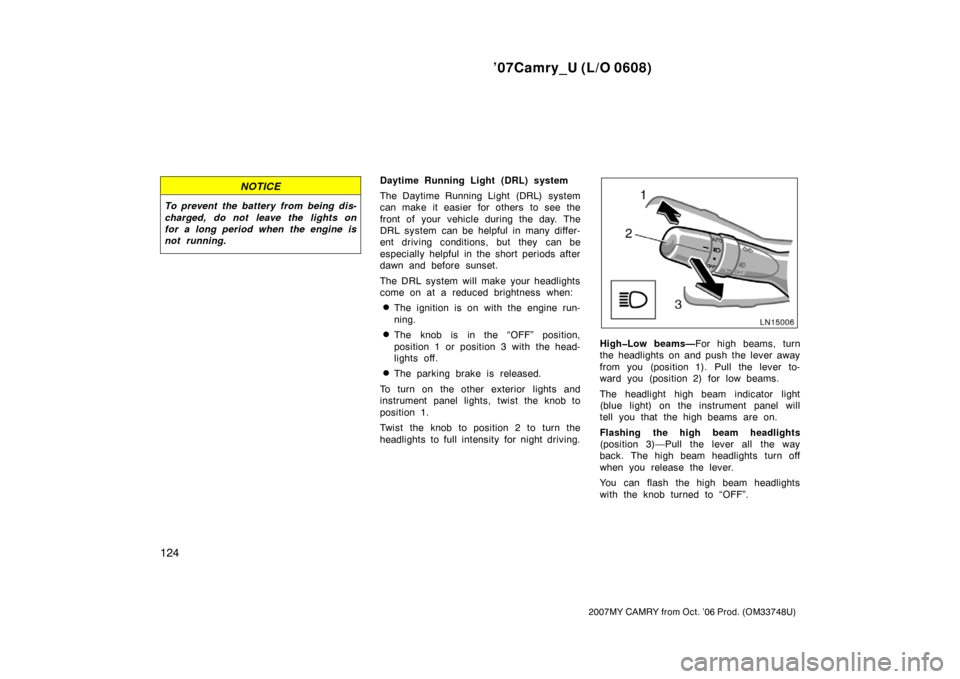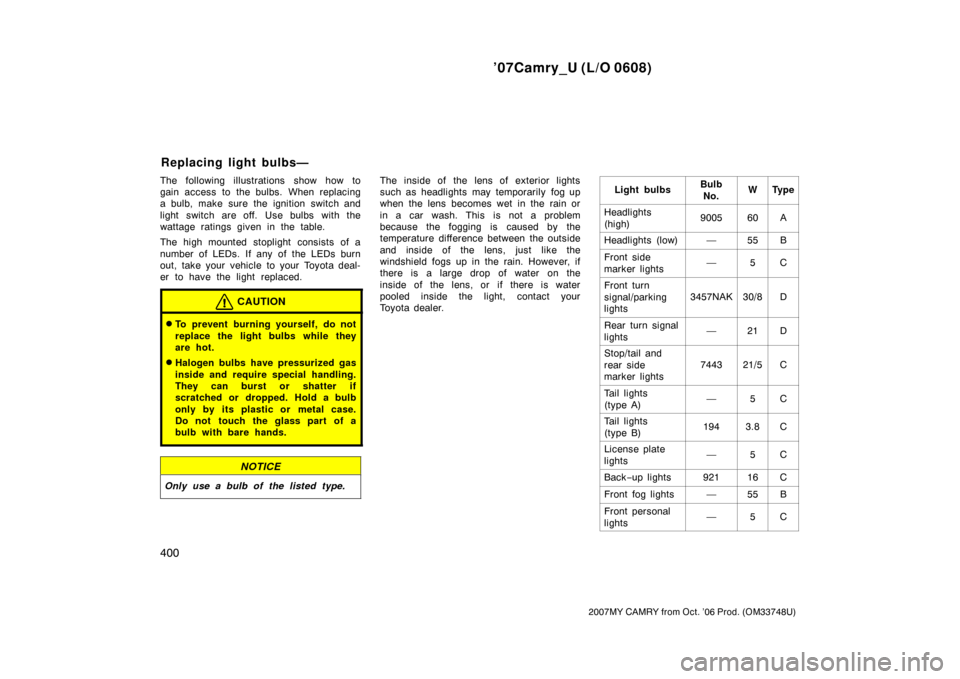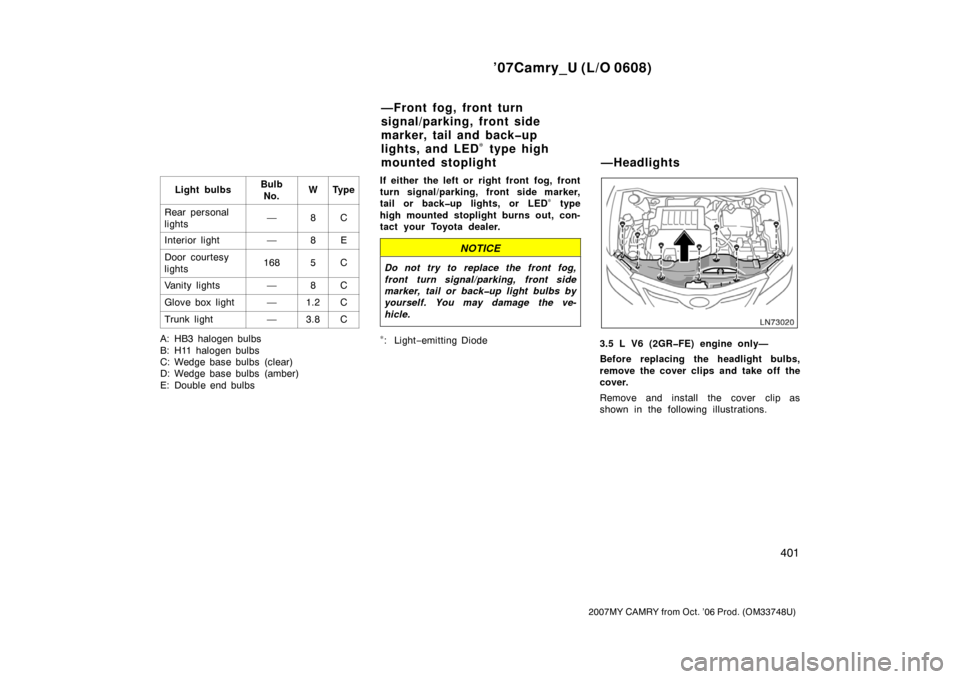Page 131 of 428

’07Camry_U (L/O 0608)
123
2007MY CAMRY from Oct. ’06 Prod. (OM33748U)
Manually twist the knob to the position 2
to turn on the headlights if they are need-
ed immediately when entering a dark tun-
nel, parking structure, etc.
When the tail lights/headlights are turned
on, the brightness of the instrument clus-
ter will be reduced slightly unless the in-
strument panel light control knob is turned
fully clockwise.
However, the brightness of the instrument
cluster will not be reduced in daytime
even when the tail lights/headlights are
turned on.
The automatic light control sensor is on
the top of the instrument panel.
Do not place anything on the instrument
panel, and/or do not affix anything on the
windshield to block this sensor.
If you feel that the automatic light control
comes into operation too early or too late,
have the sensor adjusted by your Toyota
dealer.Automatic light cut off system
Position 1—
The lights automatically turn off when the
driver ’s door is opened after the ignition
switch is set to off.
Position 2 or position 3 with the head-
lights on—
The lights automatically turn off after 30
seconds when any of the doors or trunk
lid is opened and closed after the ignition
switch is set to off.
The lights can be turned off immediately
by pushing the lock switch on the wireless
remote control transmitter with all the
doors locked and the trunk lid closed.
The time period before the lights turn off
can be changed. For details, ask your
Toyota dealer.
If any of the doors or trunk lid is kept
open, the lights automatically turn off after
20 minutes.
To turn on the lights again, set the ignition
switch at ON or actuate the headlight
switch. If you are going to park for over
one week, make sure the light switch is
in the “OFF” position.
Page 132 of 428

’07Camry_U (L/O 0608)
124
2007MY CAMRY from Oct. ’06 Prod. (OM33748U)
NOTICE
To prevent the battery from being dis-
charged, do not leave the lights on
for a long period when the engine is
not running.
Daytime Running Light (DRL) system
The Daytime Running Light (DRL) system
can make it easier for others to see the
front of your vehicle during the day. The
DRL system can be helpful in many differ-
ent driving conditions, but they can be
especially helpful in the short periods after
dawn and before sunset.
The DRL system will make your headlights
come on at a reduced brightness when:
�The ignition is on with the engine run-
ning.
�The knob is in the “OFF” position,
position 1 or position 3 with the head-
lights off.
�The parking brake is released.
To turn on the other exterior lights and
instrument panel lights, twist the knob to
position 1.
Twist the knob to position 2 to turn the
headlights to full intensity for night driving.
High�Low beams—For high beams, turn
the headlights on and push the lever away
from you (position 1). Pull the lever to-
ward you (position 2) for low beams.
The headlight high beam indicator light
(blue light) on the instrument panel will
tell you that the high beams are on.
Flashing the high beam headlights
(position 3)—Pull the lever all the way
back. The high beam headlights turn off
when you release the lever.
You can flash the high beam headlights
with the knob turned to “OFF”.
Page 134 of 428
’07Camry_U (L/O 0608)
126
2007MY CAMRY from Oct. ’06 Prod. (OM33748U)
To adjust the brightness of the instru-
ment panel lights, turn the knob.
With the knob turned fully clockwise, the
intensity of the instrument panel lights will
not be reduced even when the tail lights/
headlights are turned on.To turn on the front fog lights, twist
the band of the headlight and turn sig-
nal switch lever. They will come on
only when the headlights are on low
beam.
Front fog light indicator light on the instru-
ment panel will tell you that the front fog
lights are on.Without moon roof
With moon roof
Instrument panel light control Front fog lights Interior light
Page 376 of 428

’07Camry_U (L/O 0608)
368
2007MY CAMRY from Oct. ’06 Prod. (OM33748U)
Brake fluid level
Make sure the brake fluid level is correct.
See page 383 in Section 7−2 for addition-
al information.
Engine oil level
Check the level on the dipstick with the
engine turned off and the vehicle parked
on a level spot. See page 380 in Section
7−2 for additional information.
Power steering fluid level
Check the level through the reservoir. The
level should be in the “HOT” or “COLD”
range depending on the fluid temperature.
See page 384 in Section 7−2 for addition-
al information.
Exhaust system
If you notice any change in the sound of
the exhaust or smell exhaust fumes, have
the cause located and corrected immedi-
ately. (See “Engine exhaust cautions” on
page 290 in Section 2.)INSIDE THE VEHICLE
Items listed below should be checked
regularly, e.g. while performing periodic
services, cleaning the vehicle, etc.
Lights
Make sure the headlights, stop lights, tail
lights, turn signal lights, and other lights
are all working. Check headlight aim.
Service reminder indicators and warning
buzzers
Check that all service reminder indicators
and warning buzzers function properly.
Steering wheel
Be alert for changes in steering condition,
such as hard steering or strange noise.
Seats
Check that all front seat controls such as
seat adjusters, seatback recliner, etc. op-
erate smoothly and that all latches lock
securely in any position. Check that the
head restraints move up and down
smoothly and that the locks hold securely
in any latched position. For folding−down
rear seatbacks, check that the latches
lock securely.Seat belts
Check that the seat belt system such as
buckles, retractors and anchors operate
properly and smoothly. Make sure that the
belt webbings not cut, frayed, worn or
damaged.
Accelerator pedal
Check the pedal for smooth operation and
uneven pedal effort or catching.
Clutch pedal
Check the pedal for smooth operation.
Brake pedal
Check the pedal for smooth operation and
that the pedal has the proper clearance.
Check the brake booster function.
Brakes
In a safe place, check that the brakes do
not pull to one side when applied.
Parking brake
Check that the lever or pedal has the
proper travel and that, on a safe incline,
your vehicle is held securely with only the
parking brake applied.
Page 406 of 428
’07Camry_U (L/O 0608)
398
2007MY CAMRY from Oct. ’06 Prod. (OM33748U)
Good Blown
Ty p e A
Good Blown
Ty p e B
Good Blown
Ty p e C
If the headlights or other electrical
components do not work, check the
fuses. If any of the fuses are blown,
they must be replaced.
See “Fuse locations” on page 374 in Sec-
tion 7−1 for locations of the fuses.
Turn the ignition switch and inoperative
component off. Pull the suspected fuse
straight out and check it.
Determine which fuse may be causing the
problem. The lid of the fuse box shows
the name of the circuit for each fuse. See
page 412 in Section 8 for the functions
controlled by each circuit.
Type B fuses—When any of the fuses are
blown, contact your Toyota dealer.
Checking and replacing fuses
Page 408 of 428

’07Camry_U (L/O 0608)
400
2007MY CAMRY from Oct. ’06 Prod. (OM33748U)
The following illustrations show how to
gain access to the bulbs. When replacing
a bulb, make sure the ignition switch and
light switch are off. Use bulbs with the
wattage ratings given in the table.
The high mounted stoplight consists of a
number of LEDs. If any of the LEDs burn
out, take your vehicle to your Toyota deal-
er to have the light replaced.
CAUTION
�To prevent burning yourself, do not
replace the light bulbs while they
are hot.
�Halogen bulbs have pressurized gas
inside and require special handling.
They can burst or shatter if
scratched or dropped. Hold a bulb
only by its plastic or metal case.
Do not touch the glass part of a
bulb with bare hands.
NOTICE
Only use a bulb of the listed type.
The inside of the lens of exterior lights
such as headlights may temporarily fog up
when the lens becomes wet in the rain or
in a car wash. This is not a problem
because the fogging is caused by the
temperature difference between the outside
and inside of the lens, just like the
windshield fogs up in the rain. However, if
there is a large drop of water on the
inside of the lens, or if there is water
pooled inside the light, contact your
Toyota dealer.Light bulbsBulb
No.WTy p e
Headlights
(high)900560A
Headlights (low)—55B
Front side
marker lights—5C
Front turn
signal/parking
lights
3457NAK30/8D
Rear turn signal
lights—21D
Stop/tail and
rear side
marker lights
744321/5C
Tail lights
(type A)—5C
Tail lights
(type B)1943.8C
License plate
lights—5C
Back−up lights92116C
Front fog lights—55B
Front personal
lights—5C
Replacing light bulbs—
Page 409 of 428

’07Camry_U (L/O 0608)
401
2007MY CAMRY from Oct. ’06 Prod. (OM33748U)
Light bulbsBulb
No.WTy p e
Rear personal
lights—8C
Interior light—8E
Door courtesy
lights1685C
Vanity lights—8C
Glove box light—1.2C
Trunk light—3.8C
A: HB3 halogen bulbs
B: H11 halogen bulbs
C: Wedge base bulbs (clear)
D: Wedge base bulbs (amber)
E: Double end bulbsIf either the left or right front fog, front
turn signal/parking, front side marker,
tail or back�up lights, or LED
∗ type
high mounted stoplight burns out, con-
tact your Toyota dealer.
NOTICE
Do not try to replace the front fog,
front turn signal/parking, front side
marker, tail or back�up light bulbs by
yourself. You may damage the ve-
hicle.
∗: Light−emitting Diode3.5 L V6 (2GR�FE) engine only—
Before replacing the headlight bulbs,
remove the cover clips and take off the
cover.
Remove and install the cover clip as
shown in the following illustrations.
—Front fog, front turn
signal/parking, front side
marker, tail and back�up
lights, and LED
∗ type high
mounted stoplight —Headlights